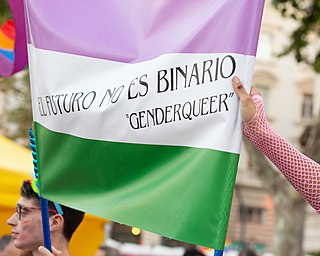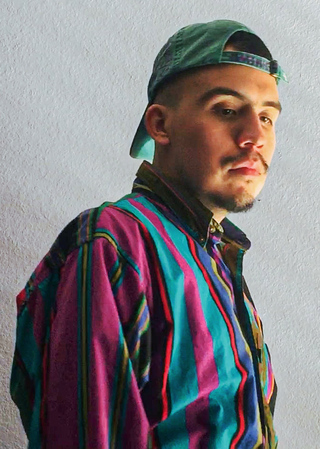
Romantic orientation, also called affectional orientation, is the classification of the sex or gender which a person experiences romantic attraction towards or is likely to have a romantic relationship with. The term is used alongside the term "sexual orientation", as well as being used alternatively to it, based upon the perspective that sexual attraction is only a single component of a larger concept.

Sexuality and gender identity-based cultures are subcultures and communities composed of people who have shared experiences, backgrounds, or interests due to common sexual or gender identities. Among the first to argue that members of sexual minorities can also constitute cultural minorities were Adolf Brand, Magnus Hirschfeld, and Leontine Sagan in Germany. These pioneers were later followed by the Mattachine Society and the Daughters of Bilitis in the United States.

The LGBT community is a loosely defined grouping of lesbian, gay, bisexual, and transgender individuals united by a common culture and social movements. These communities generally celebrate pride, diversity, individuality, and sexuality. LGBT activists and sociologists see LGBT community-building as a counterweight to heterosexism, homophobia, biphobia, transphobia, sexualism, and conformist pressures that exist in the larger society. The term pride or sometimes gay pride expresses the LGBT community's identity and collective strength; pride parades provide both a prime example of the use and a demonstration of the general meaning of the term. The LGBT community is diverse in political affiliation. Not all people who are lesbian, gay, bisexual, or transgender consider themselves part of the LGBT community.

Asexuality is the lack of sexual attraction to others, or low or absent interest in or desire for sexual activity. It may be considered a sexual orientation or the lack thereof. It may also be categorized more widely, to include a broad spectrum of asexual sub-identities.

Non-binary and genderqueer are umbrella terms for gender identities that are not solely male or female. Non-binary identities often fall under the transgender umbrella since non-binary people typically identify with a gender that is different from the sex assigned to them at birth, though some non-binary people do not consider themselves transgender.

The bisexual flag is a pride flag representing bisexuality, bisexual individuals and the bisexual community. The pink stripe represents attraction to the same gender, while the blue stripe represents attraction to the opposite gender. The purple stripe, the resulting "overlap" of the blue and pink stripes, represents attraction to all genders, including non-binary people and those of other gender identities.

A pride flag is any flag that represents a segment or part of the LGBT community. Pride in this case refers to the notion of LGBT pride. The terms LGBT flag and queer flag are often used interchangeably.
Over the course of its history, the LGBT community has adopted certain symbols for self-identification to demonstrate unity, pride, shared values, and allegiance to one another. These symbols communicate ideas, concepts, and identity both within their communities and to mainstream culture. The two symbols most recognized internationally are the pink triangle and the rainbow flag.

The rainbow flag or pride flag is a symbol of LGBT pride and LGBT social movements. The colors reflect the diversity of the LGBT community and the spectrum of human sexuality and gender. Using a rainbow flag as a symbol of LGBT pride began in San Francisco, California, but eventually became common at LGBT rights events worldwide.

Demisexuality is a sexual orientation in which an individual does not experience primary sexual attraction – the type of attraction that is based on immediately observable characteristics such as appearance or smell and is experienced immediately after a first encounter. A demisexual person can only experience secondary sexual attraction – the type of attraction that occurs after the development of an emotional bond. The amount of time that a demisexual individual needs to know another person before developing sexual attraction towards them varies from person to person. Demisexuality is generally categorized on the asexuality spectrum.

Aromanticism is a romantic orientation characterized by experiencing little to no romantic attraction. The term "aromantic", colloquially shortened to "aro", refers to a person whose romantic orientation is aromanticism.

Gray asexuality, grey asexuality, or gray-sexuality is the spectrum between asexuality and allosexuality. Individuals who identify with gray asexuality are referred to as being gray-A, gray ace, and make up what is referred to as the "ace umbrella". Within this spectrum are terms such as demisexual, semisexual, asexual-ish and sexual-ish.
Gender and sexual diversity (GSD), or simply sexual diversity, refers to all the diversities of sex characteristics, sexual orientations and gender identities, without the need to specify each of the identities, behaviors, or characteristics that form this plurality.
This is a timeline of asexual history worldwide. The briefness of this timeline can be attributed to the fact that acceptance of asexuality as a sexual orientation and field of scientific research is still relatively new.
Discrimination against asexual people, also known as acephobia or aphobia when directed at aspec people, encompasses a range of negative attitudes, behaviours, and feelings toward asexuality or people who identify as part of the asexual spectrum. Negative feelings or characterisations toward asexuality include dehumanisation, the belief that asexuality is a mental illness, that asexual people cannot feel love, and the refusal to accept asexuality as a genuine sexual orientation. Asexuality is sometimes confused with celibacy, abstinence, antisexualism, or hyposexuality.

The split attraction model (SAM) is a model in psychology that distinguishes between a person's romantic and sexual attraction, allowing the two to be different from each other.

Aze is a literary magazine for asexual, aromantic, and agender people that was created in 2016 and publishes issues online. It was formerly known as The Asexual until 2019 when it expanded to include aromantic and agender people. The magazine publishes visual art, poetry, and personal and academic essays on the subjects of asexuality, aromanticism, and agender experiences and their various intersections. It was founded by Michael Paramo.

Michael Paramo is a writer, academic, and artist known for founding the literary magazine Aze and for their work examining interpersonal attraction and love with consideration to asexuality, aromanticism, and agender identity. Paramo identifies on the asexual and aromantic spectrum and advocates for people of similar experience to express themselves toward expanding society's ideas of human sexuality, romance, and gender identity. They published a book Ending the Pursuit: Asexuality, Aromanticism, and Agender Identity in 2024.












